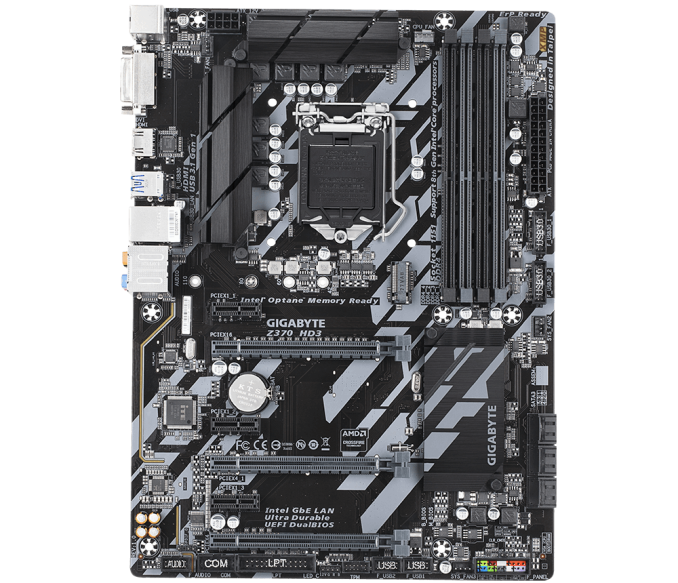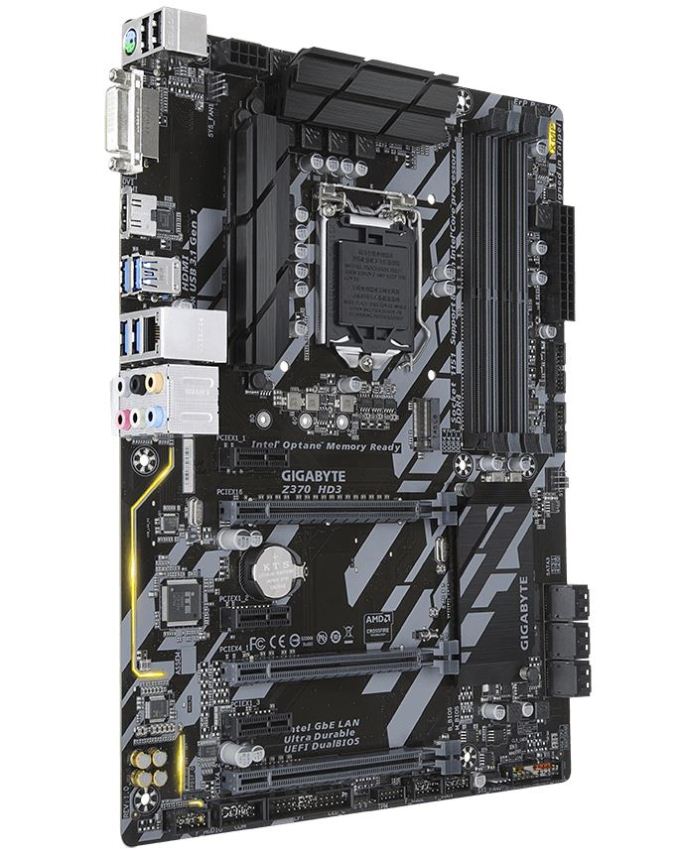Analyzing Z370 for Intel's 8th Generation Coffee Lake: A Quick Look at 50+ Motherboards
by Ian Cutress, Anton Shilov, Joe Shields & Gavin Bonshor on October 20, 2017 2:00 PM ESTGIGABYTE Z370 HD3
The last of the nine GIGABYTE boards for this article is the entry-level Z370 HD3. The HD3 slides in below the HD3P, and despite the minor name difference, has a more different layout than expected. The HD3 is a board for the budget conscious looking to get into the platform at the lowest entry point. For example, the HD3 does not have USB 3.1 (10 Gbps) ports on the board, has only one M.2 slot instead of two or three, and doesn't have slot reinforcement on any PCIe or DIMM slot.
The HD3's appearance is nearly a carbon copy of the HD3P, except the grey stenciling is on the board and chipset heatsink only, and is not on the VRM heatsinks. The memory slots are the same two black and two gray, while all PCIe slots (none with reinforcement) are grey with the PCIe x1 slots in black. The PCH heatsink is also carried over. The only non-standard LEDs on the board is the audio separation line and the XMP notification in the top right-hand corner.
Users still receive the full complement of four memory slots supporting up to 64GB in capacity, while GIGABYTE states a maximum supported speed of up to DDR4-4000. For PCIe, the two full-length slots are wired to run in an x16/x4 configuration driven by the CPU with the third also running at x4 speeds but fed from the chipset. That said, there is only support for 2-Way AMD Crossfire or AMD Quad-GPU Crossfire (2x dual GPU cards) as SLI requires x8 per slot minimum.
As mentioned earlier, the HD3 is down to one M.2 slot, the least on any of the Gigabyte boards. For most users that might be of little concern as they only have one M.2 based drive. The board contains six SATA ports supporting RAID 0, 1, 5, and 10, rounding out storage connectivity. There are a total of four fan headers on the board, with one to the right of the VRM heatsink on top, another close to the EPS 12V connector, while the other two system fans are at the bottom of the board and on the middle right side just above the SATA ports. The included Smart Fan 5 application is still able to control the hybrid PWM/Voltage controlled headers. The audio codec on the HD3 steps down to the ALC892 codec. It also does not have EMI shielding but the board design still separates the boards analog audio components from the digital components on the PCB. For networking, one of Intel's GbE LAN chips covers the network side for the HD3.
The USB side of the house is going to be fairly straightforward. From the chipset, the board has eight USB 3.1 (5 Gbps) ports with four on the back panel and for more available through internal USB headers. Users will also find six more USB 2.0 ports with two on the back panel, and four more available through internal USB headers. There are no USB 3.1 (10 Gbps) ports on this board, allowing for cost savings, although users can still purchase USB 3.1 (10 Gbps) PCIe cards to expand functionality if needed. The back panel IO also includes a combination PS/2 port, a DVI-D video output, a HDMI video output, and the audio jacks.













83 Comments
View All Comments
risa2000 - Saturday, October 21, 2017 - link
It seems that the PCB which holds the silicon has changed between the 7th and the 8th gen. So they most likely needed to validate the CPU. The fact that they did not move the notch means they just did not want to (could not) introduce a new socket. Either because there were so many of the old ones, or there was no time, or they did not want to push the cost to MB manufacturers to revalidate the new sockets.shabby - Friday, October 20, 2017 - link
For a split second i thought finally some x370 goodness... but no.Shame, shame, shame!
tamalero - Saturday, October 21, 2017 - link
I'm waiting for actual non clown disco BS Threadripper motherboards :(ikjadoon - Friday, October 20, 2017 - link
Amazingly well done. Excellent write-up.AbRASiON - Friday, October 20, 2017 - link
Stupid question, I got the AsRock simple ITX board and it won't turbo my CPU at all (8400) like no turbo PERIOD. It never ever goes over 2763mhz?Anyone got any ideas on this? Am I just stupid and this is normal behaviour or what?
https://forums.anandtech.com/threads/am-i-doing-so...
bernstein - Friday, October 20, 2017 - link
FYI: GIGABYTE Z370N-WiFi is also HDMI 2.0 capableByte - Friday, October 20, 2017 - link
If nothing else, Asus makes some damn good looking boards.docbones - Friday, October 20, 2017 - link
My big question still on the z370 is whats the 390 going to bring? Will the 370 not support a octocore chip?shabby - Friday, October 20, 2017 - link
This is intel we're talking aboot, new chip = new mobo period.Ro_Ja - Saturday, October 21, 2017 - link
Once Kaby Lake E is released, that's a new mobo again.